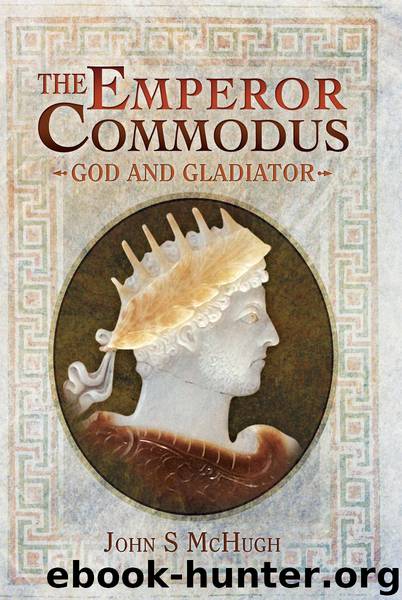The Emperor Commodus: God and Gladiator by John S. McHugh

Author:John S. McHugh [John S. McHugh]
Language: eng
Format: epub
Published: 2017-01-15T05:00:00+00:00
Chapter Six
Nemesis: The Fall of Cleander (190 AD)
The various measures and precautions made by Cleander failed to alleviate the shortage of grain. Unrest in Africa had already effected production in the province, whilst the cost of labour caused by the plague had led to much agricultural land in Italy and Sicily falling out of production as well, resulting in a famine in the capital. Coinage distributed on 1 January 190 AD records the legend ‘Everything has turned out well for the dutiful emperor.’ The coin shows Commodus sacrificing at an altar before the statue of Neptune, the God of the Sea. A second issue carries the legend Votis Felicibus (The vows turned out well), again showing Commodus and another figure sacrificing at a tripod altar in the harbour of Ostia with a slain bull and a lighthouse behind, two grain ships entering the harbour, one piloted by Serapis. Serapis was a Graeco-Egyptian god associated with resurrection and abundance. The obverse legend does not carry the usual M COMMODUS ANT P FELX AUG BRIT but IMP COMMODUS AUG PIUS FELIX, the change of emphasis in the nomenclature stressing the qualities that got him through the crisis of 189 AD: devotion to duty, in particular, religious duty. Pius, good fortune and Felix, happiness at the protection shown by the gods towards the emperor. Another issue shows the personification of Fides standing to the left holding ears of corn with the legend: ‘Loyalty of the Cohorts’. The coins would have been produced in the mints around November and December when the crisis had abated, for distribution at the start of January. The origins of the crisis are clear: Rome was already suffering famine at the start of the summer with reduced yields in the regions close to the capital, but the main supplier of grain to Rome was Egypt. The coinage suggests that poor weather delayed the embarkation of the grain fleet in March/April, hence the emperor’s sacrifices to Neptune for calm weather and his location at the main port of Rome, Ostia. As Tacitus has the Emperor Tiberius say: ‘the very existence of the people of Rome is daily at the mercy of uncertain waves and storms.’¹
It is believed up to 200,000 households in the capital were entitled to the distribution of the free grain dole or were entitled to purchase it at a very low price, but the city’s population was approaching 1,000,000, of whom 30 per cent were slaves. To provide the dole alone over 300 million tonnes of grain were needed to be transported to Rome each year and held in vast warehouses. It is estimated that by 58 BC this grain dole cost the state up to a fifth of its annual income. The grain was unloaded at Ostia or Portus from the ships, some over 1,000 tonnes, and guilds were employed to use smaller boats to move the cargo along the Tiber and canals connecting the city with its ports. To prevent corruption detailed receipts carried on
Download
This site does not store any files on its server. We only index and link to content provided by other sites. Please contact the content providers to delete copyright contents if any and email us, we'll remove relevant links or contents immediately.
Waking Up in Heaven: A True Story of Brokenness, Heaven, and Life Again by McVea Crystal & Tresniowski Alex(37500)
Empire of the Sikhs by Patwant Singh(22775)
We're Going to Need More Wine by Gabrielle Union(18647)
Hans Sturm: A Soldier's Odyssey on the Eastern Front by Gordon Williamson(18334)
Leonardo da Vinci by Walter Isaacson(12817)
The Radium Girls by Kate Moore(11639)
Tools of Titans by Timothy Ferriss(7830)
Educated by Tara Westover(7698)
How to Be a Bawse: A Guide to Conquering Life by Lilly Singh(7167)
Permanent Record by Edward Snowden(5550)
The Last Black Unicorn by Tiffany Haddish(5424)
The Rise and Fall of Senator Joe McCarthy by James Cross Giblin(5152)
Promise Me, Dad by Joe Biden(4916)
The Wind in My Hair by Masih Alinejad(4852)
The Crown by Robert Lacey(4578)
A Higher Loyalty: Truth, Lies, and Leadership by James Comey(4565)
The Iron Duke by The Iron Duke(4127)
Joan of Arc by Mary Gordon(3797)
Stalin by Stephen Kotkin(3731)
